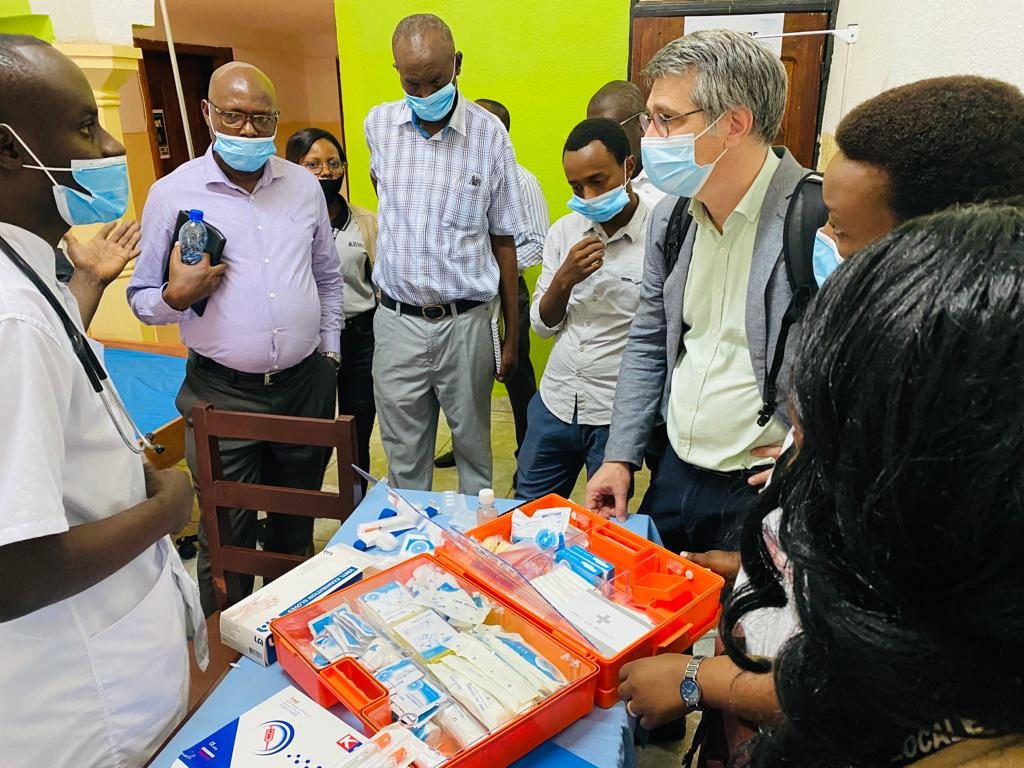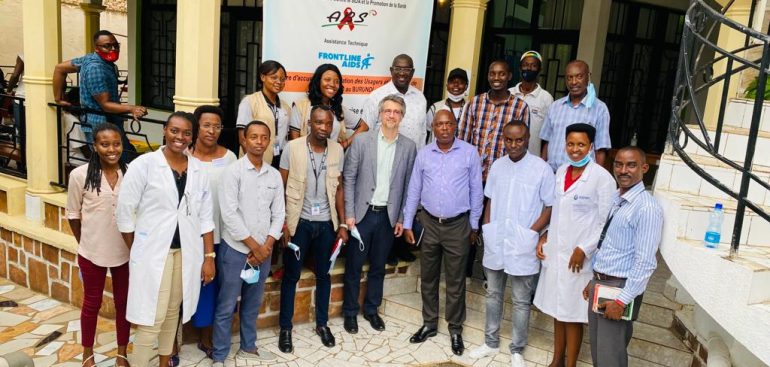Village Health Action (VHA) established a Medical Centre for drug users in 2016. This Center enables the provision of some of the services recommended by the GF, WHO, and UNODC as part of the global harm reduction package for injecting drug users (United Nations Office on Drugs and Crime).
As a result, VHA was able to carry out seven of the WHO global package interventions. Since September 2016, the project has impacted the drug user community by reducing drug-related harms such as HIV, sexually transmitted infections, tuberculosis, and other diseases in collaboration with ABS, Alliance Burundaise de lutte contre le Sida. ABS and VHA also allow people who inject drugs to receive free medical care and medication.
Since 2017, 456 new injected drug users (IDUs) have been identified and provided with psychological support; 2,300 have been educated on harm reduction; 1,200 IDUs have been tested for HIV; 18 IDUs have been placed on ARVs, and four pregnant IDUs have been referred for antenatal care. This project took an end in 2019.
VHA has been implementing the same project since September 2021, which is funded by the Initiative 5% via Expertise France and will run for three years until 2024. VHA works in collaboration with the ABMPD (Association Burundaise pour un-Monde de Paix Sans Drogues), and the ABS is the primary recipient. The technical partner is Frontline Aids. Each partner has a distinct role to play. VHA’s responsibilities include providing at least seven harm reduction services and participating in the design and advocacy for drug policy to decriminalize drug use in Burundi.
The current project’s primary goal is to improve access to harm reduction services for injecting drug users in seven Burundi provinces, including removing gender-related barriers to access. Still, VHA’s main task is in Bujumbura, where VHA medical centre is located.
The other objectives include:
- Access to harm reduction activity packages tailored to drug users’ needs, including gender-specific packages, is being improved in Bujumbura Mairie and the six other provinces.
- The capacities of peer educators, health service providers, and civil society organizations in Bujumbura Mairie and six Burundi provinces to offer harm reduction activity packages tailored to drug users and gender differences are being strengthened.
 The project aims to contribute to developing a community-based harm reduction response, i.e. empowerment and capacity building through active participation of drug users. Drug users were encouraged to define the necessary health responses and ways to combat the stigma and exclusion of which they are victims. As a result, they are project actors who participate in planning, implementation, and evaluation phases.
The project aims to contribute to developing a community-based harm reduction response, i.e. empowerment and capacity building through active participation of drug users. Drug users were encouraged to define the necessary health responses and ways to combat the stigma and exclusion of which they are victims. As a result, they are project actors who participate in planning, implementation, and evaluation phases.
People who use drugs are given services to reduce their risk of contracting infectious diseases such as HIV and hepatitis and information to help them protect themselves and others. Special consideration will be given to women and young drug users. Furthermore, sexual and reproductive health, including access to PMTCT and gender-based violence management at the community and healthcare levels, will be essential components of the project, as both are likely to exacerbate the vulnerability of female drug users. Therefore, there is a special section of the VHA medical centre dedicated to women who use drugs and are victims of GBV. The goal is to reduce the specific risks that drug-using women face while also mitigating the effects of GBV.
VHA, in collaboration with our partner ABMPD, provides short-term lodging in emergency cases for women who are unable to find shelter for GBV victims. VHA also assists victims with medical needs, including post-exposure prophylaxis for HIV. VHA makes referrals as needed and provides medical certificates that can be used for legal assistance.
Epidemiological situation:
HIV prevalence in the general population aged 15-49 years has decreased from 3.2 % in 2002 to 0.9 % in 2017. Overall, urban HIV prevalence is increasing (2.5 % vs 0.7 % in rural areas), and the epidemic is becoming more feminized (1.2% among women compared to 0.6 % among men). Girls have a threefold (0.3 %) higher prevalence than boys among young people aged 15 to 24.
However, there are still many vulnerable or at-risk groups for HIV/AIDS, including men who have sex with men (MSM), sex workers (SWs), prisoners, and people who use or inject drugs, for whom the statistics are less favourable. Thus, HIV prevalence among MSM was 4.8 % in 2013, with a population of 9,346 estimated; HIV prevalence among SP was 21.3 % in 2013, with a population of 51,482. It should be noted that these figures have not been updated in 7 years and maybe higher.
For drug users, there is currently very little data available. HIV prevalence among injecting drug users is 10.2 %, according to an ABS survey conducted in 2017 as part of a regional project funded by the Global Fund, which is ten times higher than in the general population. According to the study, the primary causes of HIV transmission are needle sharing and re-use and high incarceration rates. Female injecting drug users are also more vulnerable, according to research.
Situation among drug users:
Drug users are among those who have yet to benefit from structured and targeted interventions in HIV/AIDS prevention and other diseases by health policies (notably HCV and TB). Interventions to reduce new HIV infections in vulnerable populations are relatively new and limited due to socio-cultural, legal, and financial constraints. Nonetheless, human rights are guaranteed in Burundi’s 2018 constitution. Article 22 guarantees equality for all and expressly prohibits discrimination based on HIV or other diseases. Articles 52 and 55 also guarantee the right to health care, indicating that the right to health must be prioritized in the HIV response. However, the most recent STIGMA index report from 2015 shows that discriminatory/stigmatizing attitudes toward PLHIV persist, with key populations being the most abused by the system and the population.
When it comes to HIV, discriminatory attitudes toward women are more common than discriminatory attitudes toward men, according to the Demographic and Health Survey, DHS. The DHS survey focuses primarily on women in general. The drug-using community reflects women’s lower social status in society. Furthermore, drug use among women is stigmatized more than among men, as it is seen as incompatible with the roles and responsibilities assigned to women.
These discriminations and gender inequalities will be addressed in the project, both broadly and specifically for active female drug users.
Burundi’s response analysis revealed a lack of gender sensitivity and coverage of HIV awareness activities, particularly in rural and peri-urban areas. The low level of literacy among women (68 %), the lack of knowledge about HIV infection, the persistence of false beliefs and harmful traditional practices, and the lack of intervention targeting young girls all contribute to the deterioration of Burundi’s epidemiological situation of young girls and women.
Furthermore, gender-based violence (GBV) remains a reality. According to DHS III, one in every four women has experienced sexual violence at some point in their lives. According to the Association of Women Lawyers of Burundi, this violence goes unpunished, which recorded over 1,000 cases of GBV in 2018. The law enacted on September 22, 2016, on the prevention, protection of victims, and repression of gender-based violence is entirely unknown in communities.
These factors explain why women are more vulnerable in general and female injecting drug users.
Pilot Program for Harm Reduction Plan for implementation in the VHA medical centre, offering a package of at least seven services.
VHA’s goal is to provide drug users with a minimum package of seven harm reduction services. Because women are often overlooked in certain situations, the pilot program will help to break down gender stereotypes, empower female drug users, prevent, and manage GBV.
The program is implemented through an integrated approach based on ABMPD’s joint and complementary medical services and community actions.
The project’s eighth service in the harm reduction package is naloxone overdose management. This molecule is theoretically approved as a medicine to treat overdose in Burundi, but it is not routinely used. As a result, a strong pledge will be made to include this 8th service in the VHA Centre and the community.
The VHA centre has a trained multidisciplinary team (doctors, social workers, psychologists, community workers, users, and peer educators) to expand the centre’s activities and provide appropriate, high-quality health care to drug users and injecting drug users.
The following services are in plan to be available in the centre:
- Provision of meals and washing facilities,
- Distribution of syringes,
- Referral for screening for diseases associated with injecting drug use
- HIV, tuberculosis, hepatitis B and C, syphilis screening, treatment, and prevention
- Availability of ARV or referral for ARV and TB treatment,
- Distribution of condoms and lubricants,
- Women comprehensive care including PMTCT.
VHA has received little equipment support to open and operate an outpatient for injecting drug users, provides the equipment and medical materials needed to treat drug users and injecting drug users, including syringes, and prevent overdoses.

